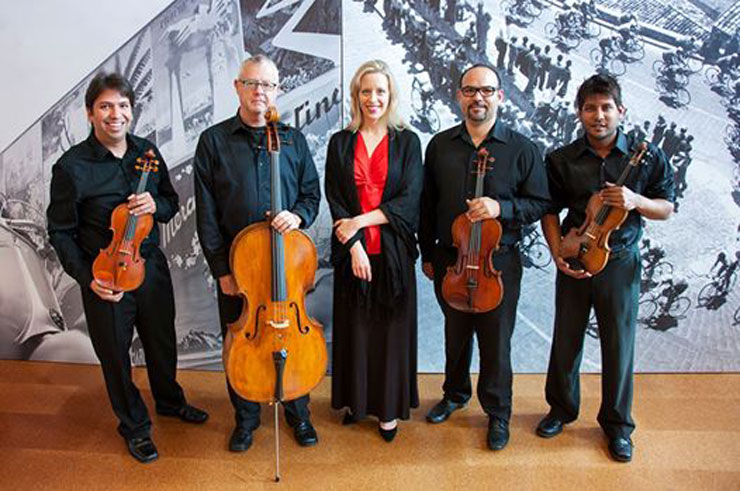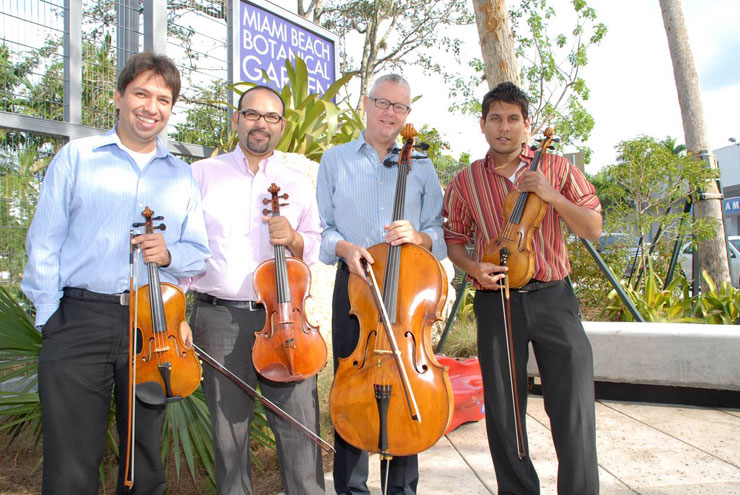
Outside the community hall, stitched in the Miami Beach Botanical Garden's plush greenery, is the trunk of a sea grape tree with many thick trunks protruding from its base and traces of various perfumes in the air.
Inside the hall was another force of nature, embodied in two violins, a viola, a cello and a pretty soprano.
The South Beach Chamber Ensemble served up their program – Made in America – in this ideally intimate setting on March 1, featuring the music of Lee Hoiby, Samuel Barber and Antonín Dvořák.
Hoiby, best known for his songs and operas, was an American Romantic composer, productive during most of the 20th century. His lyrical and expressive song style made a fine fit for settings from William Shakespeare's text – Sonnets and Soliloquies – originally scored for soprano and piano and later retooled for soprano and string quartet.
The attractive Anna Hersey sang the bard's four verses. Duke Orsino's soliloquy from Twelfth Night ("If music be the food of love, play on…") and Sonnet 128 dealt conveniently with musical themes: Hoiby, possibly taking a cue from Orsino ("That strain again! It had a dying fall”), crafted a descending musical line for instrument and voice, while Sonnet 128 ended with an amusing pizzicato, perhaps mimicking "that blessed wood whose motion sounds with thy sweet fingers" referred to in the poem.
The final couplet from Sonnet 116 was beautifully framed by Hersey and the quartet. She and the SBCE were five well-tuned instruments playing together as a single being in this most beloved of Shakespearean sonnets.
Hersey rendered Portia's mercy seasons justice plea powerfully and with the theatrical sense that if The Merchant of Venice had been a musical, Hoiby's music might have been its score. The serious vaulting upward music was splendid, dramatically resolved by the violins at its conclusion.
Lady of the Harbor, a song using a partial text from The New Colossus, Emma Lazarus's famous sonnet inscribed on the base of the Statue of Liberty, sounded of waves, perhaps suggesting the arrival of immigrants to America.
Where the Music Comes From, a song with the only known text by Hoiby himself and arranged for soprano and string quartet by Luis Fernandez, was a highlight. The lyric "I want to walk in the earthly garden" coordinated well with the surroundings as seen through the glass walls of the botanical hall. The sparkle in Hersey's face matched her voice, her hopeful and twinkling interpretation of the melody combined with SBCE's undulating accompaniment was another moment well spent on this sunny afternoon.
The SBCE players – violin Tony Seepersad, violin Luis Fernandez, viola Rafael Ramirez, cello Michael Andrews – once again demonstrated their world class skill with Barber's String Quartet in B minor, Op. 11.

Admittedly, for almost 30 years I've avoided listening to the "Adagio for Strings," the second movement of Barber's quartet arranged for string orchestra, as it tended to punch up in my head the image from Oliver Stone's film Platoon. Prior to the film, I was drawn to the rising pathos of the piece over and over again, but the slow motion image of Sargent Elias running and throwing his arms up in the air as a last gesture before dying in a fusillade of bullets, killed my drive to listen to it.
SBCE brought me back to the original. Somehow, with only the four voices of the quartet playing the adagio, there was more depth to it than realized in a full string orchestra.
SBCE was precisely on point with the passionate opening unison of the first movement, which morphed into a lovely chorale and then into a longing melody. The foursome strove mightily, ascending and descending with purpose. The uncoiling of the famous adagio was shared by all the voices, Seepersad's violin claiming the first articulation of the melody, each instrument then taking a skillful turn with it. The ensem climaxed within the high range of their instruments, finally retreating into the stillness that is the soul of the movement. The brief third revisited themes from the opening.
Though Antonín Dvořák was not American, he wrote his String Quartet in F major, Op. 96 while on summer vacation in the Czech immigrant community of Spillville, Iowa.
It had been long conjectured that Dvořák used specific American influences such as African-American spirituals or Native American ritual music in his quartet, though none of these are credibly documented. However, one has only to hear the first notes of this extraordinary work to sense something overtly American about it. After all, it was nicknamed "American Quartet" for good reasons that may go beyond merely having been written in America.
Ramirez's viola had first honors with the melody that opens the piece. Each player quoted the lively theme as they passed it to one another. A folksy element dramatically developed and angled towards a fugato (each voice repeating the motif in turn), the quartet ending the movement with the same precision that began it.
Fernandez and Andrews dominated the second movement, alternating back and forth with their violin and cello, both emotionally and technically superb in their handling of the plaintive theme. The voices faded into the quiet air as Andrews brought the movement to rest.
The one confirmed musical reference in the quartet is the song of the scarlet tanager, Dvořák having transcribed the bird’s song in his notebook. Fernandez’s violin was the tanager, rendering the high quirky tune early in the third movement. The spritely group then navigated the cross-rhythms, lofting up and landing as softly as they lifted.
SBCE scampered in the finale, chasing and playing its pleasant little melody directly into the heart of the audience.
The only drawback to the afternoon concert was that there was no encore!
 MAIN MENU
MAIN MENU

